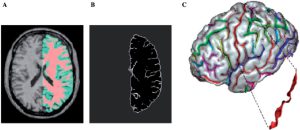Abstract
Focal cortical dysplasia (FCD) is often characterized by minor structural changes that may go unrecognized by standard radiological analysis. Visual assessment of morphological characteristics of FCD and sulci harbouring them is difficult due to the complexity of brain convolutions. Our purpose was to elucidate and quantify the spatial relationship between FCD lesions and brain sulci using automated sulcal extraction and morphometry. We studied 43 consecutive FCD patients using high-resolution MRI. Lesions were classified into small and large using qualitative (detection on initial clinical assessment of conventional MRI) and quantitative (volume) criteria. Sulci were identified and labelled automatically using an algorithm based on a congregation of neural networks. Segmented FCD lesions and sulci were then simultaneously visualized in 3D. We measured mean and maximum depth of sulci related to each FCD and of the corresponding sulci in 21 healthy controls. In addition, we calculated sulcal depth within the FCD neighbourhood. Twenty-one (21/43 = 49%) patients had small FCD lesions (volume range: 128-3093 mm(3)). Among them, 17 (81%) had been overlooked during initial radiological evaluation and were subsequently identified using image processing. Eighteen (18/21 = 86%) small FCD lesions were located at the bottom of a sulcus. Two others were related to the walls of two sulci and one was located at the crown of a gyrus. Mean and maximum depth of sulci related to the FCD was higher than that of the corresponding sulci in controls (P < 0.008). Sulcal depth within lesional neighbourhood had larger mean depth than that of the entire sulcus (P < 0.0002). Evidence that small FCD lesions are preferentially located at the bottom of an abnormally deep sulcus may be used to direct the search for developmental abnormalities, particularly in patients in whom large-scale MRI features are only mildly abnormal or absent.

